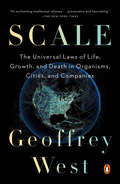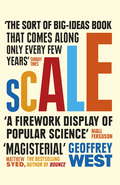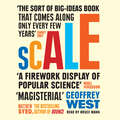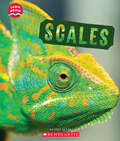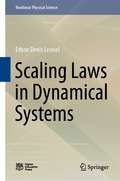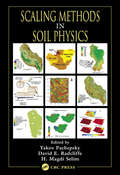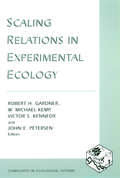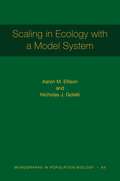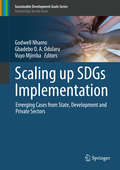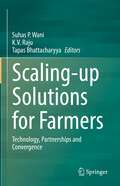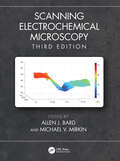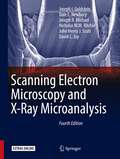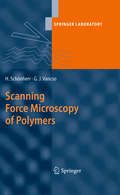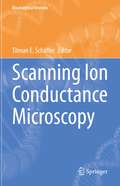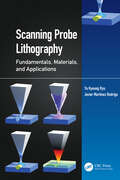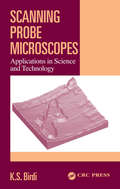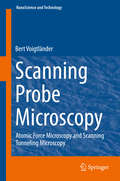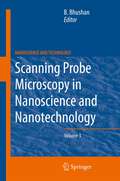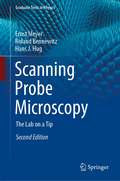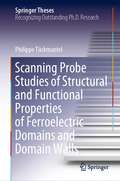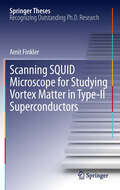- Table View
- List View
Scale: The Universal Laws of Growth, Innovation, Sustainability, and the Pace of Life in Organisms, Cities, Economies, and Companies (Santa Fe Institute Studies On The Sciences Of Complexity)
by Geoffrey WestFrom one of the most influential scientists of our time, a dazzling exploration of the hidden laws that govern the life cycle of everything from plants and animals to the cities we live in.Visionary physicist Geoffrey West is a pioneer in the field of complexity science, the science of emergent systems and networks. The term “complexity” can be misleading, however, because what makes West’s discoveries so beautiful is that he has found an underlying simplicity that unites the seemingly complex and diverse phenomena of living systems, including our bodies, our cities and our businesses. Fascinated by aging and mortality, West applied the rigor of a physicist to the biological question of why we live as long as we do and no longer. The result was astonishing, and changed science: West found that despite the riotous diversity in mammals, they are all, to a large degree, scaled versions of each other. If you know the size of a mammal, you can use scaling laws to learn everything from how much food it eats per day, what its heart-rate is, how long it will take to mature, its lifespan, and so on. Furthermore, the efficiency of the mammal’s circulatory systems scales up precisely based on weight: if you compare a mouse, a human and an elephant on a logarithmic graph, you find with every doubling of average weight, a species gets 25% more efficient—and lives 25% longer. Fundamentally, he has proven, the issue has to do with the fractal geometry of the networks that supply energy and remove waste from the organism’s body. West’s work has been game-changing for biologists, but then he made the even bolder move of exploring his work’s applicability. Cities, too, are constellations of networks and laws of scalability relate with eerie precision to them. Recently, West has applied his revolutionary work to the business world. This investigation has led to powerful insights into why some companies thrive while others fail. The implications of these discoveries are far-reaching, and are just beginning to be explored. Scale is a thrilling scientific adventure story about the elemental natural laws that bind us together in simple but profound ways. Through the brilliant mind of Geoffrey West, we can envision how cities, companies and biological life alike are dancing to the same simple, powerful tune.
Scale: The Universal Laws of Life and Death in Organisms, Cities and Companies
by Geoffrey WestGeoffrey West's research centres on a quest to find unifying principles and patterns connecting everything, from cells and ecosystems to cities, social networks and businesses.Why do organisms and ecosystems scale with size in a remarkably universal and systematic fashion?Is there a maximum size of cities? Of animals and plants? What about companies?Can scale show us how to create a more sustainable future?By applying the rigour of physics to questions of biology, visionary physicist Geoffrey West found that despite the riotous diversity in the sizes of mammals, they are all, to a large degree, scaled versions of each other. This speaks to everything from how long we can expect to live to how many hours of sleep we need. He then made the even bolder move of exploring his work's applicability to cities and to the business world. These investigations have led to powerful insights about the elemental natural laws that bind us together in profound ways, and how all complex systems are dancing to the same simple tune, however diverse and unrelated they may seem.
Scale: The Universal Laws of Life and Death in Organisms, Cities and Companies
by Geoffrey WestGeoffrey West's research centres on a quest to find unifying principles and patterns connecting everything, from cells and ecosystems to cities, social networks and businesses.'An absolutely riveting read . . . groundbreaking' Marcus du Sautoy'This book will expand your thinking from three dimensions to four' Nassim Nicholas Taleb'Scale is a firework display of popular science' Niall Ferguson'This is an important and original book, of immense scope' Lord Martin Rees, Astronomer RoyalScale addresses big, urgent questions about global sustainability, population explosion, urbanization, ageing, cancer, human lifespans and the increasing pace of life, but also encourages us to question the world around us. Why can we live for 120 years but not for a thousand? Why does the pace of life continually increase? Why do mice live for just two or three years and elephants for up to 75? Why do companies behave like mice, and are they all destined to die? Do cities, companies and human beings have natural, pre-determined lifespans? Are we just a fascinating experiment in natural selection that is ultimately doomed to fail? And what is the origin of the magic number 4 that seems to determine much of physiology and life-history from birth to death?Read by Bruce Mann(p) 2017 Penguin Random House
Scale: Understanding the Environment
by Cristian SuteanuThis book provides up-to-date, in-depth and accessible information on the concept of scale, and focuses on its applications in geography, Earth science, environmental science, and other fields in which the environment plays a significant role. Although the book presents methods and applications as a response to practical challenges, it is primarily concept-centered: it identifies a set of distinct, yet related notions of “scale”, analyzing and elucidating their evolving meanings in a systematic way. Concepts are defined with a focus on their practical operational applicability, and the introduction of methods is supported by concrete examples. The book links theoretical insights to illustrating applications, involving a broad range of themes, from maps, fractals, and chaos theory to fine art and literature. It approaches the subject in a spatial, temporal, and spatio-temporal context, including a wide diversity of spatial features from Earth and other planets, as well as time series and space-time patterns. This monograph is expected to be useful especially because in practice the various scale-focused concepts are not neatly separated and immiscible. It is therefore helpful for scholars in physical and human geography, Earth and environmental sciences, and other fields, to benefit from a clear conceptual framework that distinguishes and illuminates the various scale-related concepts and their interconnections. Selected chapters can also support a deeper understanding of the concept of scale for graduate and undergraduate students in geography, the natural sciences, and the humanities. Information on recommended additional literature and comments about specific sources offer a guide to further reading on the topics addressed in the book.
Scales (Learn About)
by Eric GeronLet's learn all about the different types of animal coverings!Which animals have scales? Fish! Did you know that some birds, reptiles, and mammals can also have scales? Discover all the incredible ways scales help animals survive. With amazing photos and lively text, this book explains how scales help animals stay warm or cool, move, protect themselves, and more! Get ready to learn all about scales!ABOUT THE SERIES:Animals have different body coverings for different reasons. Some animals use their coverings to keep warm or stay cool, others use them for protection, and can either stand out or blend in. Some animals even use their coverings to move! This vibrant new set of Learn About books gives readers a close-up look at five different animal coverings, from fur and feathers to skin, scales, and shells. Each book is packed with photographs and fun facts that explore how each covering suits the habitat, diet, survival, and life cycle of various animals in the natural world.
Scaling Impact: Finance and Investment for a Better World
by Kusisami HornbergerThe global challenges confronting us — climate change, poverty, inequality, and many others — can feel overwhelming. Those of us who believe in market-based solutions to these challenges get even more disheartened when we regularly see our existing capitalist system failing us, often causing more harm than good. Many examples show how the capitalist tools of finance and investment can and make real, positive impact. Approaches like blended finance and impact investing can help accelerate progress against the world’s biggest remaining collective challenges. Yet use of these improved capitalist approaches remains far too subscale. Blended finance and impact investing remain 15 to 200 times smaller than traditional approaches to finance and investment. How can we continue to make capitalism work better by scaling these approaches and others? This book looks at how we can start making these necessary changes using strategies, structures, and practices that take advantage of capitalism's strengths. Its goal is to demonstrate how a reimagined financial system can be more inclusive and accountable to all. By shifting away from extractive, short-term practices in the name of shareholder primacy, we can move toward a system that values the role of all stakeholders.
Scaling Laws in Dynamical Systems (Nonlinear Physical Science)
by Edson Denis LeonelThis book discusses many of the common scaling properties observed in some nonlinear dynamical systems mostly described by mappings. The unpredictability of the time evolution of two nearby initial conditions in the phase space together with the exponential divergence from each other as time goes by lead to the concept of chaos. Some of the observables in nonlinear systems exhibit characteristics of scaling invariance being then described via scaling laws. From the variation of control parameters, physical observables in the phase space may be characterized by using power laws that many times yield into universal behavior. The application of such a formalism has been well accepted in the scientific community of nonlinear dynamics. Therefore I had in mind when writing this book was to bring together few of the research results in nonlinear systems using scaling formalism that could treated either in under-graduation as well as in the post graduation in the several exact programs but no earlier requirements were needed from the students unless the basic physics and mathematics. At the same time, the book must be original enough to contribute to the existing literature but with no excessive superposition of the topics already dealt with in other text books. The majority of the Chapters present a list of exercises. Some of them are analytic and others are numeric with few presenting some degree of computational complexity.
Scaling Methods in Soil Physics
by Yakov Pachepsky David E. Radcliffe H. Magdi SelimThe scaling issue remains one of the largest problems in soil science and hydrology. This book is a unique compendium of ideas, conceptual approaches, techniques, and methodologies for scaling soil physical properties. Scaling Methods in Soil Physics covers many methods of scaling that will be useful in helping scientists across a range of soil-rel
Scaling Relations in Experimental Ecology
by Gardner Robert H. W. Michael Kemp John E. Petersen Victor S. KennedyThis book discusses the impact of recent advances in the theory of "scaling relationships" and identifies critical issues that must be considered if experimental results are used to understand the temporal and spatial scales of actual ecosystems.
Scaling in Ecology with a Model System (Monographs in Population Biology #118)
by Aaron M. Ellison Nicholas J. GotelliA groundbreaking approach to scale and scaling in ecological theory and practiceScale is one of the most important concepts in ecology, yet researchers often find it difficult to find ecological systems that lend themselves to its study. Scaling in Ecology with a Model System synthesizes nearly three decades of research on the ecology of Sarracenia purpurea—the northern pitcher plant—showing how this carnivorous plant and its associated food web of microbes and macrobes can inform the challenging question of scaling in ecology.Drawing on a wealth of findings from their pioneering lab and field experiments, Aaron Ellison and Nicholas Gotelli reveal how the Sarracenia microecosystem has emerged as a model system for experimental ecology. Ellison and Gotelli examine Sarracenia at a hierarchy of spatial scales—individual pitchers within plants, plants within bogs, and bogs within landscapes—and demonstrate how pitcher plants can serve as replicate miniature ecosystems that can be studied in wetlands throughout the United States and Canada. They show how research on the Sarracenia microecosystem proceeds much more rapidly than studies of larger, more slowly changing ecosystems such as forests, grasslands, lakes, or streams, which are more difficult to replicate and experimentally manipulate.Scaling in Ecology with a Model System offers new insights into ecophysiology and stoichiometry, demography, extinction risk and species distribution models, food webs and trophic dynamics, and tipping points and regime shifts.
Scaling up SDGs Implementation: Emerging Cases from State, Development and Private Sectors (Sustainable Development Goals Series)
by Godwell Nhamo Vuyo Mjimba Gbadebo O. A. OdularuThis volume challenges global leaders and citizenry to do more in order to resource the implementation of the 2030 Agenda for Sustainable Development (AfSD) and its 17 interwoven Sustainable Development Goals (SDGs). Starting from the concept ‘we cannot manage what we cannot measure’, the book presents some cases showing how to draw national level baselines for the domestication and localisation of the SDGs seeking to provide a clear roadmap towards achieving the 2030 AfSD. Scaling up SDGs Implementation is targeted at the United Nations, national and state governments, sub-national governments, the corporate sector and civil society, including higher education institutes, labour groups, non-governmental organisations and youth movements. The book is cognizant of these institutions’ common, but differentiated responsibilities and capabilities within their socio-political, environmental and economic conditions. The book presents case studies of how the corporate sector has been scaling up SDGs implementation, from the tourism sector, insurance, to the aviation and agricultural sectors. To make sure that no one is left behind, the volume includes cases on solutions for pressing environmental and socio-economic problems ranging from cooperatives in Brazil to the conservation of springs in Zimbabwe. The matter of finding synergies between the climate SDG and the Paris Agreement’s Nationally Determined Contributions (NDCs) is elaborated at length. Lastly, the book discusses how institutions of higher education remain critical pillars in SDGs scaling up, with cases of curriculum re-orientation in South Africa to the rolling out of the Women’s University in Africa. In this context, this volume challenges every global citizen and organization to invest every effort into making the implementation of the SDGs a success as we welcome the second four to five year segment down the road to the year 2030.
Scaling-up Solutions for Farmers: Technology, Partnerships and Convergence
by Tapas Bhattacharyya K. V. Raju Suhas P. WaniThis book provides a unique account of cross-sectoral innovations through efficient partnerships based on the hands-on experience of internationally renowned contributors specialised in the field of Science of Delivery. The challenges and lessons learned from large development initiatives based in Asia, and from the work undertaken by international research institutions, such as the FAO, are brought together in this book to benefit development agencies, policy makers, corporates, post graduate students, farmers’ organizations, and those involved in supplying agricultural inputs and/or buying agricultural produce, particularly in developing countries within Asia and Africa. Through a number of case studies the book describes how the consortium approach of capacity building for equitable and efficient benefits, collective action, and convergence, will benefit millions of small farm-holders in different regions of Asia
Scaling: Why is animal size so important?
by Knut Schmidt-NielsenThis book is about the importance of animal size. We tend to think of animal function in chemical terms and talk of water, salts, proteins, enzymes, oxygen, energy, and so on. We should not forget, however, that physical laws are equally important, for they determine rates of diffusion and heat transfer, transfer of force and momentum, the strength of structures, the dynamics of locomotion, and other aspects of the functioning of animal bodies. Physical laws provide possibilities and opportunities for an organism, yet they also impose constraints, setting limits to what is physically possible. This book aims to give an understanding of these rules because of their profound implications when we deal with animals of widely different size and scale. The reader will find that the book raises many questions. Remarkable and puzzling information makes it read a little like a detective story, but the last chapter, instead of giving the final solution, neither answers all questions nor provides one great unifying principle.
Scanning Electrochemical Microscopy
by Allen J. BardBecause of its simplicity of use and quantitative results, Scanning Electrochemical Microscopy (SECM) has become an indispensable tool for the study of surface reactivity. The fast expansion of the SECM field over several years has been fueled by the introduction of new probes, commercially available instrumentation, and new practical applications. Scanning Electrochemical Microscopy, Third Edition offers essential background and in-depth overviews of specific applications in self-contained chapters. The vitality and growing popularity of SECM over the past 30+ years have largely been determined by its versatility and capability to remain useful in the changing scientific and technological environments. New applications reported during the last decade reflect significant current activity in biomedical and energy-related research. This thoroughly updated edition provides up-to-date comprehensive reviews of different aspects of SECM. New chapters by renowned professionals in the field cover recent advances in different areas of SECM including nanoSECM, surface reactions and films, batteries, and fuel cells. Expanded coverage of electrocatalysis and surface interrogation as well as photoelectrochemistry and photoelectrocatalysis are also provided. Useful for a broad range of interdisciplinary research—from biological systems to nanopatterning—this book is invaluable to all interested in learning and applying SECM.
Scanning Electron Microscopy and X-Ray Microanalysis: Third Edition
by David C. Joy Joseph I. Goldstein Dale E. Newbury Joseph R. Michael Nicholas W.M. Ritchie John Henry J. ScottThis thoroughly revised and updated Fourth Edition of a time-honored text provides the reader with a comprehensive introduction to the field of scanning electron microscopy (SEM), energy dispersive X-ray spectrometry (EDS) for elemental microanalysis, electron backscatter diffraction analysis (EBSD) for micro-crystallography, and focused ion beams. Students and academic researchers will find the text to be an authoritative and scholarly resource, while SEM operators and a diversity of practitioners -- engineers, technicians, physical and biological scientists, clinicians, and technical managers -- will find that every chapter has been overhauled to meet the more practical needs of the technologist and working professional. In a break with the past, this Fourth Edition de-emphasizes the design and physical operating basis of the instrumentation, including the electron sources, lenses, detectors, etc. In the modern SEM, many of the low level instrument parameters are now controlled and optimized by the microscope''s software, and user access is restricted. Although the software control system provides efficient and reproducible microscopy and microanalysis, the user must understand the parameter space wherein choices are made to achieve effective and meaningful microscopy, microanalysis, and micro-crystallography. Therefore, special emphasis is placed on beam energy, beam current, electron detector characteristics and controls, and ancillary techniques such as energy dispersive x-ray spectrometry (EDS) and electron backscatter diffraction (EBSD). With 13 years between the publication of the third and fourth editions, new coverage reflects the many improvements in the instrument and analysis techniques. The SEM has evolved into a powerful and versatile characterization platform in which morphology, elemental composition, and crystal structure can be evaluated simultaneously. Extension of the SEM into a "dual beam" platform incorporating both electron and ion columns allows precision modification of the specimen by focused ion beam milling. New coverage in the Fourth Edition includes the increasing use of field emission guns and SEM instruments with high resolution capabilities, variable pressure SEM operation, theory, and measurement of x-rays with high throughput silicon drift detector (SDD-EDS) x-ray spectrometers. In addition to powerful vendor- supplied software to support data collection and processing, the microscopist can access advanced capabilities available in free, open source software platforms, including the National Institutes of Health (NIH) ImageJ-Fiji for image processing and the National Institute of Standards and Technology (NIST) DTSA II for quantitative EDS x-ray microanalysis and spectral simulation, both of which are extensively used in this work. However, the user has a responsibility to bring intellect, curiosity, and a proper skepticism to information on a computer screen and to the entire measurement process. This book helps you to achieve this goal. Realigns the text with the needs of a diverse audience from researchers and graduate students to SEM operators and technical managers Emphasizes practical, hands-on operation of the microscope, particularly user selection of the critical operating parameters to achieve meaningful results Provides step-by-step overviews of SEM, EDS, and EBSD and checklists of critical issues for SEM imaging, EDS x-ray microanalysis, and EBSD crystallographic measurements Makes extensive use of open source software: NIH ImageJ-FIJI for image processing and NIST DTSA II for quantitative EDS x-ray microanalysis and EDS spectral simulation. Includes case studies to illustrate practical problem solving Covers Helium ion scanning microscopy Organized into relatively self-contained modules - no need to "read it all" to understand a topic Includes an online supplement--an extensive "Database of Electron-Solid Interactions"--which can be accessed on SpringerLink, in Chapter 3
Scanning Electron Microscopy for the Life Sciences
by Heide SchattenRecent developments in scanning electron microscopy (SEM) have resulted in a wealth of new applications for cell and molecular biology, as well as related biological disciplines. It is now possible to analyze macromolecular complexes within their three-dimensional cellular microenvironment in near native states at high resolution, and to identify specific molecules and their structural and molecular interactions. New approaches include cryo-SEM applications and environmental SEM (ESEM), staining techniques and processing applications combining embedding and resin-extraction for imaging with high resolution SEM, and advances in immuno-labeling. New developments include helium ion microscopy, automated block-face imaging combined with serial sectioning inside an SEM chamber, and Focused Ion Beam Milling (FIB) combined with block-face SEM. With chapters written by experts, this guide gives an overview of SEM and sample processing for SEM, and highlights several advances in cell and molecular biology that greatly benefited from using conventional, cryo, immuno, and high-resolution SEM.
Scanning Force Microscopy of Polymers
by Holger Schönherr G. Julius VancsoThis lab manual introduces the reader to scanning force microscopy of polymers based on a practice-oriented approach. It begins with a broad introduction to the necessary background of SFM, including intermolecular forces and various SFM imaging modes. "Scanning Force Microscopy of Polymers" is developed in a didactically clear and easily understandable style. The application of SFM to visualize and study polymers is exemplified by numerous case studies, including experimental protocols. In addition, the book helps the reader to develop a conscious and critical understanding of SFM data. This approach enables the reader to acquire the knowledge and experimental skills that are necessary to understand and obtain good and reliable SFM results within the shortest time possible.
Scanning Ion Conductance Microscopy (Bioanalytical Reviews #3)
by Tilman E. SchäfferThis book provides a selection of recent developments in scanning ion conductance microscopy (SICM) technology and applications. In recent years, SICM has been applied in an ever-increasing number of areas in the bioanalytical sciences. SICM is based on an electrolyte-filled nanopipette with a nanometer-scale opening, over which an electric potential is applied. The induced ion current is measured, which allows to directly or indirectly quantify various physical quantities such as pipette-sample distance, ion concentration, sample elastic modulus among many others. This makes SICM well suited for applications in electrolytes - most prominently for the study of live cells.This book starts with a historic overview starting from the days of the invention of SICM by Paul Hansma at the University of California at Santa Barbara in 1989. SICM is a member of the family of scanning probe microscopies. It is related to another prominent member of the family, atomic force microscopy (AFM), which has found application in almost any field of nanoscale science. The advantages and disadvantages of SICM over AFM are also outlined. One of the most effective and break-through applications of SICM nanopipettes is in electrochemistry. The different routes and applications for doing electrochemistry using nanopipettes are also discussed. In addition the book highlights the ability of SICM for surface positioning with nanometer precision to open up new vistas in patch clamp measurements subcellular structures. Finally the book presents one research area where SICM has been making a lot of contributions, cardiac research and the endeavors to combine SICM with super-resolution optical microscopy for highest-resolution joint topography and functional imaging.
Scanning Probe Lithography: Fundamentals, Materials, and Applications (Emerging Materials and Technologies)
by Yu Kyoung Ryu Javier Martinez RodrigoThe most complete book available on scanning probe lithography (SPL), this work details the modalities, mechanisms, and current technologies, applications, and materials on which SPL can be performed. It provides a comprehensive overview of this simple and cost-effective technique, which does not require clean room conditions and can be performed in any lab or industry facility to achieve high-resolution and high-quality patterns on a wide range of materials: biological, semiconducting, polymers, and 2D materials. • Introduces historical background of SPL, including evolution of the technique and tools • Explains the mechanism of sample modification/manipulation, types of AFM tips, technical parts of the experimental setup, and materials on which the technique can be applied • Shows the different types of devices and structures fabricated by SPL, together with the processing steps • Contains a complete and state-of-the art package of examples and different approaches, performed by different international research groups • Summarizes strengths, limitations, and potential of SPL This book is aimed at advanced students, technicians, and researchers in materials science, microelectronics, and others working with lithographic techniques and fabrication processes.
Scanning Probe Microscopes: Applications in Science and Technology
by K. S. BirdiScanning Probe Microscopes: Applications in Science and Technology explains, analyzes, and demonstrates the most widely used microscope in the family of microscopes -- the scanning probe microscope. Beginning with an introduction to the development of SPMs, the author introduces the basics of scanning tunneling and atomic force microscopes (STMs an
Scanning Probe Microscopy
by Bert VoigtländerThis book explains the operating principles of atomic force microscopy and scanning tunneling microscopy. The aim of this book is to enable the reader to operate a scanning probe microscope successfully and understand the data obtained with the microscope. The chapters on the scanning probe techniques are complemented by the chapters on fundamentals and important technical aspects. This textbook is primarily aimed at graduate students from physics, materials science, chemistry, nanoscience and engineering, as well as researchers new to the field.
Scanning Probe Microscopy in Nanoscience and Nanotechnology 3
by Bharat BhushanThis book presents the physical and technical foundation of the state of the art in applied scanning probe techniques. It constitutes a timely and comprehensive overview of SPM applications. The chapters in this volume relate to scanning probe microscopy techniques, characterization of various materials and structures and typical industrial applications, including topographic and dynamical surface studies of thin-film semiconductors, polymers, paper, ceramics, and magnetic and biological materials. The chapters are written by leading researchers and application scientists from all over the world and from various industries to provide a broader perspective.
Scanning Probe Microscopy: The Lab on a Tip (Graduate Texts in Physics)
by Ernst Meyer Roland Bennewitz Hans J. HugWritten by three leading experts in the field, this textbook describes and explains all aspects of the scanning probe microscopy. Emphasis is placed on the experimental design and procedures required to optimize the performance of the various methods. Scanning Probe Microscopy covers not only the physical principles behind scanning probe microscopy but also questions of instrumental designs, basic features of the different imaging modes, and recurring artifacts. The intention is to provide a general textbook for all types of classes that address scanning probe microscopy. Third year undergraduates and beyond should be able to use it for self-study or as textbook to accompany a course on probe microscopy. Furthermore, it will be valuable as reference book in any scanning probe microscopy laboratory. Novel applications and the latest important results are also presented, and the book closes with a look at the future prospects of scanning probe microscopy, also discussing related techniques in nanoscience. Ideally suited as an introduction for graduate students, the book will also serve as a valuable reference for practising researchers developing and using scanning probe techniques.
Scanning Probe Studies of Structural and Functional Properties of Ferroelectric Domains and Domain Walls (Springer Theses)
by Philippe TückmantelThis thesis explores the fascinating properties of domain walls in ferroelectric materials. Domain walls can be used as model systems to study fundamental aspects of interface physics, such as crackling noise, with implications extending to a broad variety of systems, from material fracture and earthquakes to solar flares and collective decision making. Ferroelectric domain walls also show functional properties absent from the domains themselves, such as enhanced conduction leading to the tantalizing possibility of reconfigurable nanoelectronic circuitry where domain walls are active components. This work discusses the crackling physics of domain walls in thin films of Pb(Zr0.2Ti0.8)O3, as well as links between the local conductivity of domain walls and nanoscale geometrical distortions due to defects, and discusses unusual polarization textures with rotational components at crossings of ferroelastic twin domains. The results presented in this thesis have important implications for the experimental study of crackling systems.
Scanning SQUID Microscope for Studying Vortex Matter in Type-II Superconductors
by Amit FinklerCommon methods of local magnetic imaging display either a high spatial resolution and relatively poor field sensitivity (MFM, Lorentz microscopy), or a relatively high field sensitivity but limited spatial resolution (scanning SQUID microscopy). Since the magnetic field of a nanoparticle or nanostructure decays rapidly with distance from the structure, the achievable spatial resolution is ultimately limited by the probe-sample separation. This thesis presents a novel method for fabricating the smallest superconducting quantum interference device (SQUID) that resides on the apex of a very sharp tip. The nanoSQUID-on-tip displays a characteristic size down to 100 nm and a field sensitivity of 10^-3 Gauss/Hz^(1/2). A scanning SQUID microsope was constructed by gluing the nanoSQUID-on-tip to a quartz tuning-fork. This enabled the nanoSQUID to be scanned within nanometers of the sample surface, providing simultaneous images of sample topography and the magnetic field distribution. This microscope represents a significant improvement over the existing scanning SQUID techniques and is expected to be able to image the spin of a single electron.
